2008 Hyundai Santa Fe Indicator
[x] Cancel search: IndicatorPage 11 of 355

F9
1. Steering Wheel .........................................................1-118
2. Horn and Driver's Air bag ................................ 1-119, 1-44
3. Instrument Cluster ........................................................1-62
4. Ignition Switch ................................................................ 1-7
5. Hazard Warning Switch ...............................................1-83
6. Front Window Defroster Switch ................................1-141
7. Digital Clock .................................................................1-84
8. Rear Window Defroster Switch (If installed) ................1-83
9. Passenger Air bag Off Indicator ...................................1-52
10. Rear Air Conditioning Switch (If installed) ...............1-141
11. Passenger's Air bag .....................................................1-51
12. Multi-Function Light Switch .........................................1-7513. Hood Release Lever ................................................1-115
14. Parking Brake Pedal (If installed) .............................1-108
15. Windshield Wiper/Washer Switch ...............................1-78
16. Heating/Air Conditioning Control Panel ...................1-125
17. Cigarette Lighter ..........................................................1-85
18. Center Console Box ....................................................1-96
19. Shift Lever (If installed) ................................................2-10
20. Power Outlet ................................................................1-86
21. Ashtray.........................................................................1-85
22. Glove Box ....................................................................1-95
23. Audio System (If installed) ........................................1-147
CAUTION:
When installing a container of liquid air freshener inside the vehicle, do not place it near the instrument cluster
nor on the instrument panel surface. If there is any leakage from the air freshener onto these areas
(Instrument cluster, instrument panel or air ventilator), it may damage these parts. If the liquid from the air
freshener does leak onto these areas, wash them with water immediately.
!
Page 12 of 355
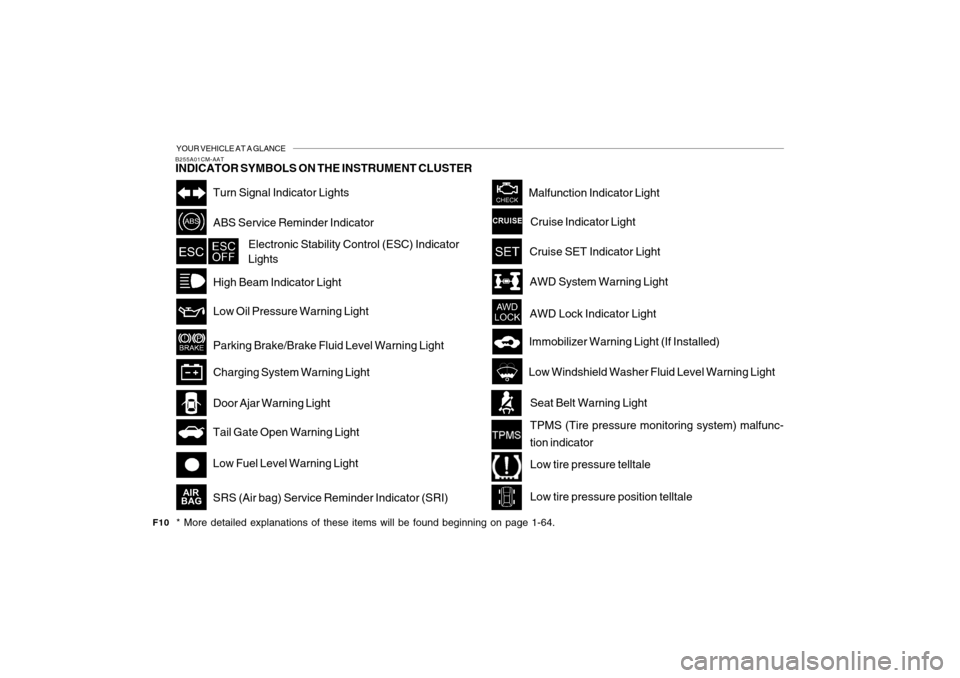
YOUR VEHICLE AT A GLANCE
F10
B255A01CM-AATINDICATOR SYMBOLS ON THE INSTRUMENT CLUSTER* More detailed explanations of these items will be found beginning on page 1-64.
AWD System Warning LightMalfunction Indicator Light
SRS (Air bag) Service Reminder Indicator (SRI) Tail Gate Open Warning LightLow Fuel Level Warning LightDoor Ajar Warning LightABS Service Reminder IndicatorTurn Signal Indicator LightsHigh Beam Indicator Light
Low Oil Pressure Warning Light
Parking Brake/Brake Fluid Level Warning Light
Charging System Warning LightImmobilizer Warning Light (If Installed)
AWD Lock Indicator LightCruise SET Indicator LightCruise Indicator LightLow Windshield Washer Fluid Level Warning Light
Seat Belt Warning Light
Electronic Stability Control (ESC) Indicator
Lights
TPMS (Tire pressure monitoring system) malfunc-
tion indicatorLow tire pressure telltale
Low tire pressure position telltale
Page 13 of 355
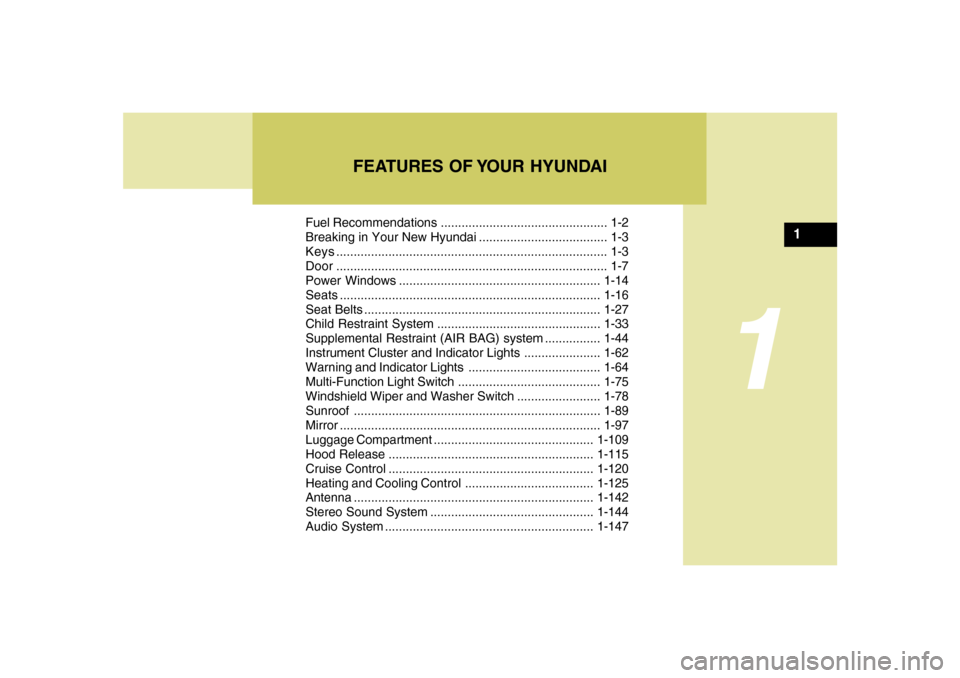
1
Fuel Recommendations ................................................ 1-2
Breaking in Your New Hyundai ..................................... 1-3
Keys.............................................................................. 1-3
Door .............................................................................. 1-7
Power Windows..........................................................1-14
Seats...........................................................................1-16
Seat Belts....................................................................1-27
Child Restraint System ...............................................1-33
Supplemental Restraint (AIR BAG) system ................1-44
Instrument Cluster and Indicator Lights...................... 1-62
Warning and Indicator Lights......................................1-64
Multi-Function Light Switch .........................................1-75
Windshield Wiper and Washer Switch ........................1-78
Sunroof.......................................................................1-89
Mirror...........................................................................1-97
Luggage Compartment ..............................................1-109
Hood Release ...........................................................1-115
Cruise Control...........................................................1-120
Heating and Cooling Control .....................................1-125
Antenna.....................................................................1-142
Stereo Sound System...............................................1-144
Audio System............................................................1-147
1
FEATURES OF YOUR HYUNDAI
Page 18 of 355
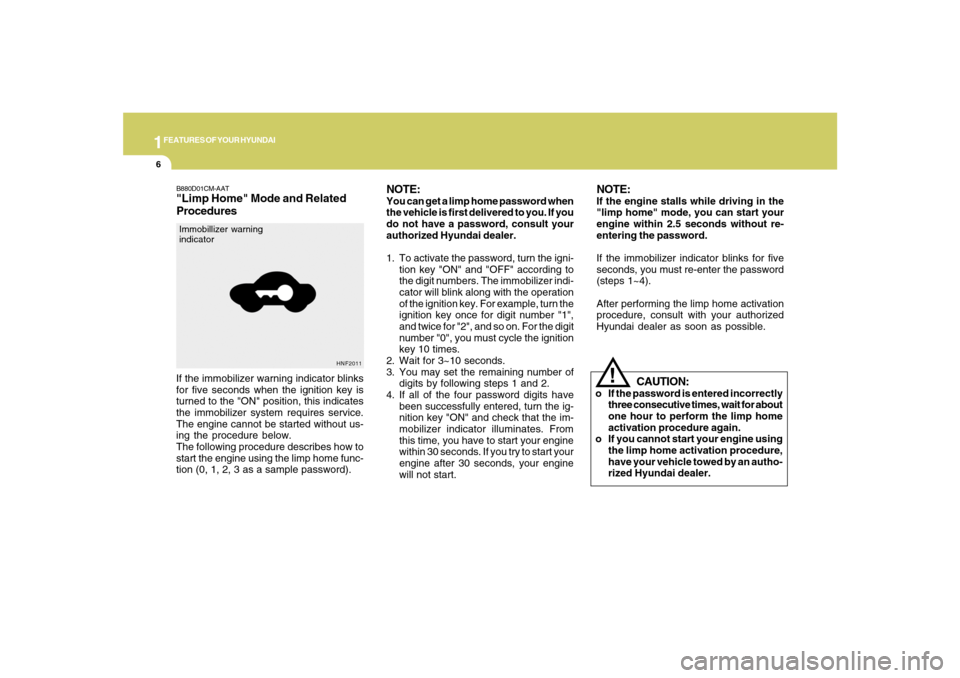
1FEATURES OF YOUR HYUNDAI6
!
If the immobilizer warning indicator blinks
for five seconds when the ignition key is
turned to the "ON" position, this indicates
the immobilizer system requires service.
The engine cannot be started without us-
ing the procedure below.
The following procedure describes how to
start the engine using the limp home func-
tion (0, 1, 2, 3 as a sample password).
CAUTION:
o If the password is entered incorrectly
three consecutive times, wait for about
one hour to perform the limp home
activation procedure again.
o If you cannot start your engine using
the limp home activation procedure,
have your vehicle towed by an autho-
rized Hyundai dealer.
B880D01CM-AAT"Limp Home" Mode and Related
Procedures
HNF2011
Immobillizer warning
indicator
NOTE:You can get a limp home password when
the vehicle is first delivered to you. If you
do not have a password, consult your
authorized Hyundai dealer.
1. To activate the password, turn the igni-
tion key "ON" and "OFF" according to
the digit numbers. The immobilizer indi-
cator will blink along with the operation
of the ignition key. For example, turn the
ignition key once for digit number "1",
and twice for "2", and so on. For the digit
number "0", you must cycle the ignition
key 10 times.
2. Wait for 3~10 seconds.
3. You may set the remaining number of
digits by following steps 1 and 2.
4. If all of the four password digits have
been successfully entered, turn the ig-
nition key "ON" and check that the im-
mobilizer indicator illuminates. From
this time, you have to start your engine
within 30 seconds. If you try to start your
engine after 30 seconds, your engine
will not start.
NOTE:If the engine stalls while driving in the
"limp home" mode, you can start your
engine within 2.5 seconds without re-
entering the password.
If the immobilizer indicator blinks for five
seconds, you must re-enter the password
(steps 1~4).
After performing the limp home activation
procedure, consult with your authorized
Hyundai dealer as soon as possible.
Page 50 of 355
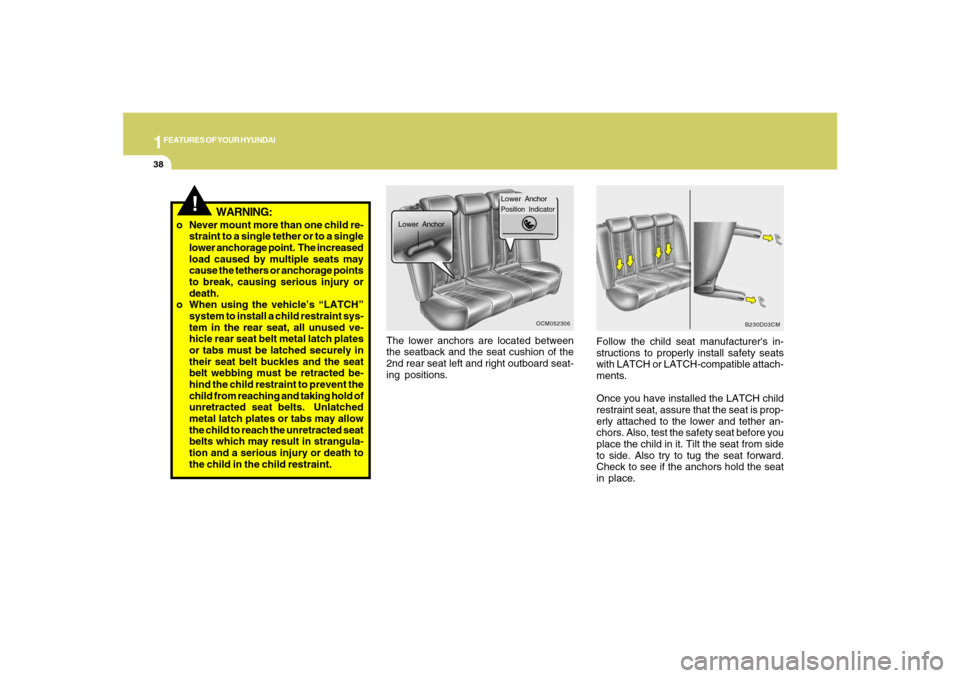
1FEATURES OF YOUR HYUNDAI38
The lower anchors are located between
the seatback and the seat cushion of the
2nd rear seat left and right outboard seat-
ing positions.Follow the child seat manufacturer's in-
structions to properly install safety seats
with LATCH or LATCH-compatible attach-
ments.
Once you have installed the LATCH child
restraint seat, assure that the seat is prop-
erly attached to the lower and tether an-
chors. Also, test the safety seat before you
place the child in it. Tilt the seat from side
to side. Also try to tug the seat forward.
Check to see if the anchors hold the seat
in place.
Lower AnchorPosition Indicator
Lower Anchor
OCM052306
B230D03CM
!
o Never mount more than one child re-
straint to a single tether or to a single
lower anchorage point. The increased
load caused by multiple seats may
cause the tethers or anchorage points
to break, causing serious injury or
death.
o When using the vehicle’s “LATCH”
system to install a child restraint sys-
tem in the rear seat, all unused ve-
hicle rear seat belt metal latch plates
or tabs must be latched securely in
their seat belt buckles and the seat
belt webbing must be retracted be-
hind the child restraint to prevent the
child from reaching and taking hold of
unretracted seat belts. Unlatched
metal latch plates or tabs may allow
the child to reach the unretracted seat
belts which may result in strangula-
tion and a serious injury or death to
the child in the child restraint.
WARNING:
Page 59 of 355
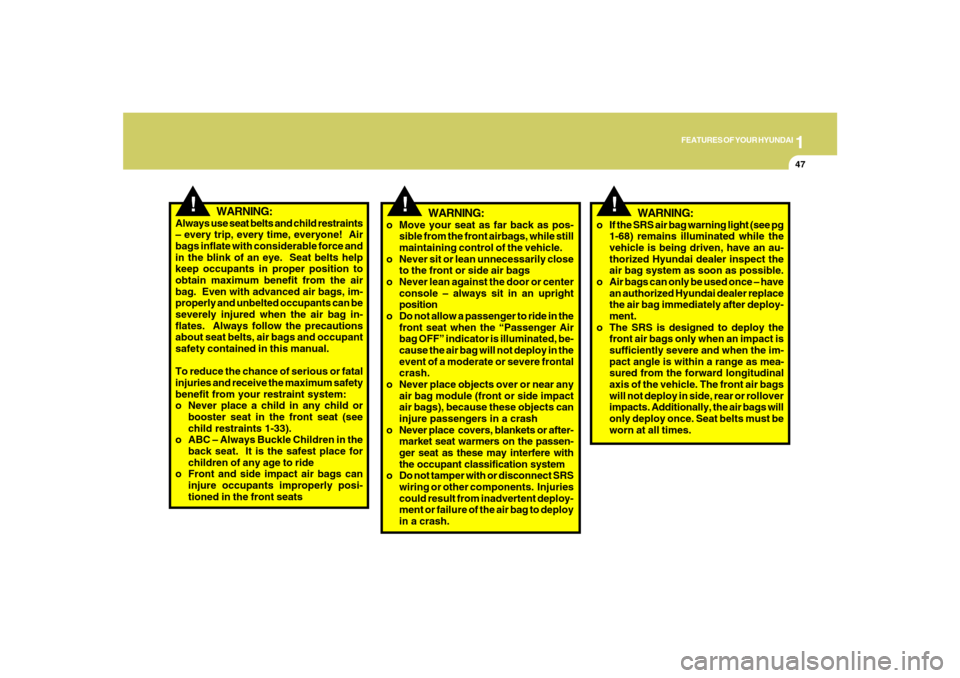
1
FEATURES OF YOUR HYUNDAI
47
!
!
WARNING:
!
WARNING:
Always use seat belts and child restraints
– every trip, every time, everyone! Air
bags inflate with considerable force and
in the blink of an eye. Seat belts help
keep occupants in proper position to
obtain maximum benefit from the air
bag. Even with advanced air bags, im-
properly and unbelted occupants can be
severely injured when the air bag in-
flates. Always follow the precautions
about seat belts, air bags and occupant
safety contained in this manual.
To reduce the chance of serious or fatal
injuries and receive the maximum safety
benefit from your restraint system:
o Never place a child in any child or
booster seat in the front seat (see
child restraints 1-33).
o ABC – Always Buckle Children in the
back seat. It is the safest place for
children of any age to ride
o Front and side impact air bags can
injure occupants improperly posi-
tioned in the front seatso Move your seat as far back as pos-
sible from the front airbags, while still
maintaining control of the vehicle.
o Never sit or lean unnecessarily close
to the front or side air bags
o Never lean against the door or center
console – always sit in an upright
position
o Do not allow a passenger to ride in the
front seat when the “Passenger Air
bag OFF” indicator is illuminated, be-
cause the air bag will not deploy in the
event of a moderate or severe frontal
crash.
o Never place objects over or near any
air bag module (front or side impact
air bags), because these objects can
injure passengers in a crash
o Never place covers, blankets or after-
market seat warmers on the passen-
ger seat as these may interfere with
the occupant classification system
o Do not tamper with or disconnect SRS
wiring or other components. Injuries
could result from inadvertent deploy-
ment or failure of the air bag to deploy
in a crash.o If the SRS air bag warning light (see pg
1-68) remains illuminated while the
vehicle is being driven, have an au-
thorized Hyundai dealer inspect the
air bag system as soon as possible.
o Air bags can only be used once – have
an authorized Hyundai dealer replace
the air bag immediately after deploy-
ment.
o The SRS is designed to deploy the
front air bags only when an impact is
sufficiently severe and when the im-
pact angle is within a range as mea-
sured from the forward longitudinal
axis of the vehicle. The front air bags
will not deploy in side, rear or rollover
impacts. Additionally, the air bags will
only deploy once. Seat belts must be
worn at all times.
WARNING:
Page 61 of 355
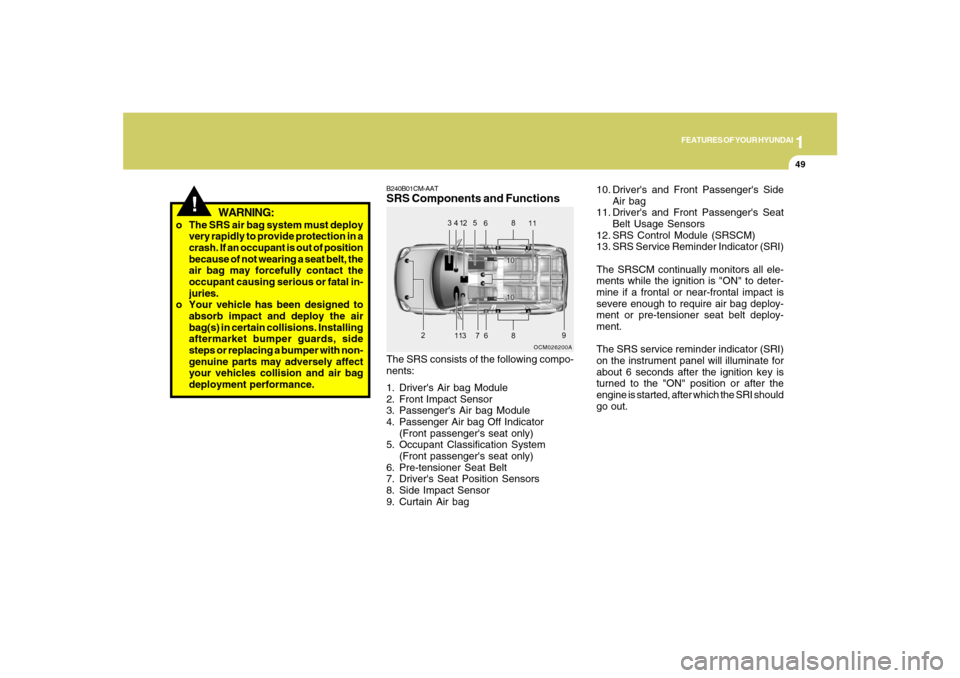
1
FEATURES OF YOUR HYUNDAI
49
!
WARNING:
o The SRS air bag system must deploy
very rapidly to provide protection in a
crash. If an occupant is out of position
because of not wearing a seat belt, the
air bag may forcefully contact the
occupant causing serious or fatal in-
juries.
o Your vehicle has been designed to
absorb impact and deploy the air
bag(s) in certain collisions. Installing
aftermarket bumper guards, side
steps or replacing a bumper with non-
genuine parts may adversely affect
your vehicles collision and air bag
deployment performance.
B240B01CM-AATSRS Components and FunctionsThe SRS consists of the following compo-
nents:
1. Driver's Air bag Module
2. Front Impact Sensor
3. Passenger's Air bag Module
4. Passenger Air bag Off Indicator
(Front passenger's seat only)
5. Occupant Classification System
(Front passenger's seat only)
6. Pre-tensioner Seat Belt
7. Driver's Seat Position Sensors
8. Side Impact Sensor
9. Curtain Air bag
OCM026200A
10. Driver's and Front Passenger's Side
Air bag
11. Driver's and Front Passenger's Seat
Belt Usage Sensors
12. SRS Control Module (SRSCM)
13. SRS Service Reminder Indicator (SRI)
The SRSCM continually monitors all ele-
ments while the ignition is "ON" to deter-
mine if a frontal or near-frontal impact is
severe enough to require air bag deploy-
ment or pre-tensioner seat belt deploy-
ment.
The SRS service reminder indicator (SRI)
on the instrument panel will illuminate for
about 6 seconds after the ignition key is
turned to the "ON" position or after the
engine is started, after which the SRI should
go out.
Page 64 of 355
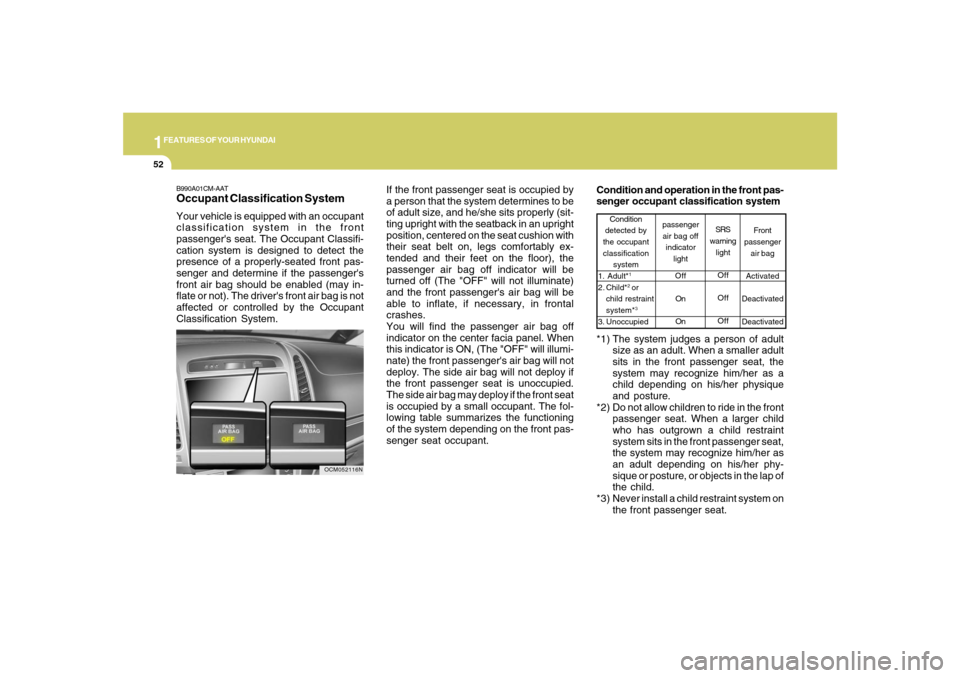
1FEATURES OF YOUR HYUNDAI52
If the front passenger seat is occupied by
a person that the system determines to be
of adult size, and he/she sits properly (sit-
ting upright with the seatback in an upright
position, centered on the seat cushion with
their seat belt on, legs comfortably ex-
tended and their feet on the floor), the
passenger air bag off indicator will be
turned off (The "OFF" will not illuminate)
and the front passenger's air bag will be
able to inflate, if necessary, in frontal
crashes.
You will find the passenger air bag off
indicator on the center facia panel. When
this indicator is ON, (The "OFF" will illumi-
nate) the front passenger's air bag will not
deploy. The side air bag will not deploy if
the front passenger seat is unoccupied.
The side air bag may deploy if the front seat
is occupied by a small occupant. The fol-
lowing table summarizes the functioning
of the system depending on the front pas-
senger seat occupant.*1) The system judges a person of adult
size as an adult. When a smaller adult
sits in the front passenger seat, the
system may recognize him/her as a
child depending on his/her physique
and posture.
*2) Do not allow children to ride in the front
passenger seat. When a larger child
who has outgrown a child restraint
system sits in the front passenger seat,
the system may recognize him/her as
an adult depending on his/her phy-
sique or posture, or objects in the lap of
the child.
*3) Never install a child restraint system on
the front passenger seat. Condition and operation in the front pas-
senger occupant classification system
Front
passenger
air bag
Activated
Deactivated
Deactivated Condition
detected by
the occupant
classification
system
1. Adult*
1
2. Child*
2 or
child restraint
system*3
3. UnoccupiedSRS
warning
light
Off
Off
Off passenger
air bag off
indicator
light
Off
On
On
B990A01CM-AATOccupant Classification SystemYour vehicle is equipped with an occupant
classification system in the front
passenger's seat. The Occupant Classifi-
cation system is designed to detect the
presence of a properly-seated front pas-
senger and determine if the passenger's
front air bag should be enabled (may in-
flate or not). The driver's front air bag is not
affected or controlled by the Occupant
Classification System.
OCM052116N